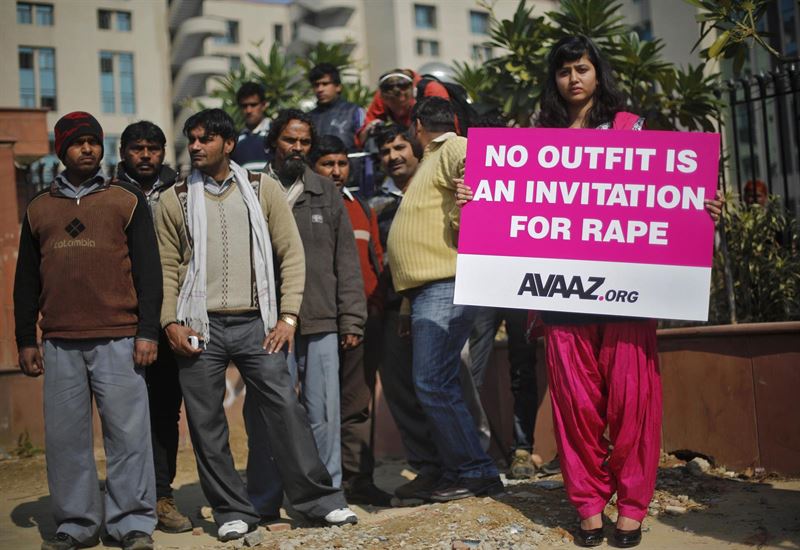Recently, a friend shared with me that her undergraduate Muslim student group had declined to cosponsor a Take Back the Night event – an internationally held rally or candlelight vigil that speaks out against rape, sexual assault, and sexual abuse. The reason given was that a Muslimah in the group felt that it would be “endorsing the way these women dress and behave.”
The insinuation was two-fold: (1) that “these” women – presumably not Muslim, wearing sheer or skintight clothes and liberally applied make-up, and presumably behaving provocatively – were inviting the assault and abuse that the event was designed to speak out against; and (2) that the women on the other end of the spectrum, presumably “our” women, pious and hijab-clad, were not victims to such assaults.
Unfortunately, this Muslimah’s belief that a woman’s dress can incite or avert rape, simply based on how much or how little fabric is worn, is not uncommon to hear in Muslim communities. It also is not true. For example, regarding the recent brouhaha over IMF Managing Director Dominique Strauss-Kahn’s alleged sexual assault of a West African Muslim maid at his hotel suite, the fact that she wore a headscarf and was a devout woman was initially deemed a sign of her innocent character.
For me, such stories are a sordid reminder of my friend Noor.* She is the exemplar Muslim woman: opinionated, ambitious, happy-go-lucky and incredibly intelligent. One day, while we were undergraduates she confessed to me, amid tears and trepidation, that she had been sexually assaulted and harassed by a professor. Noor’s story isn’t unique – the statistics show a horrific reality in the United States, where someone is sexually assaulted every two minutes and where 1 in 4 college women have either been raped or suffered attempted rape – but what made her story stand apart for me was that Noor wore the hijab. Noor blamed herself for what had happened. After all, she wore the headscarf – the alleged protector against men’s inflamed desires – and thus must have done something, or acted in some way, to have “made” the professor behave the way he did – right?
The reality could not be further from the truth. Statistics show that 44 percent of sexual assault victims are under the age of 18 and approximately two-thirds of assaults are committed by someone known to the survivor. Also, at least 70 percent of women with developmental disabilities experience sexual assault. Does it still seem like sexual assault is the result of provocative clothing when it comes to an 8 year-old girl, a woman in a wheelchair, or a woman raped by her uncle?
Noor’s is one of many such stories I have heard in recent years, especially since I started working as a counselor for sexual assault survivors. Many of these women do not fit the assumed assault or rape victim stereotype. At the time of the attack they were wearing sweatpants and an oversized shirt. They were wearing a jilbab. They were at home or at school. They were virgins. They struggled. They said no. Other women walked home alone, wearing something that showed a bit of leg or cleavage, and were not touched. The difference was not in what they were doing or what they were wearing. The difference was the presence of a rapist or assailant.
Focusing on the clothing and behavior of the survivor is wrong for two main reasons. First, blaming the survivor falls under what psychologists call the “Just World Phenomenon.” That is, most of us want to believe in a world that is fair and just – that bad things do not happen to good people who are cautious and not involved in risky behavior. This worldview leads us to conjure up ways to blame the victim. Second, in a patriarchal environment, our attention to women’s dress and character has been used to shift the focus away from the perpetrator’s actions. As recent twists in the DSK case demonstrate, the media coverage has taken a turn to blaming the victim, neglecting the bruises found in her groin area, Strauss-Kahn’s abrupt departure from the hotel following the incident, and that he has been accused of being a sexual predator by other women with more social power.
These two factors are a great part of why existing efforts to combat sexual violence focus on lecturing women about what they should be doing to avoid rape, instead of talking to men about the fact they do not have the right to women’s bodies without explicit consent. In Muslim circles, some believe sexual violence will disappear once a woman wears the headscarf properly, and is both appropriately vigilant and modest in conduct and character. The burden of reigning in sexual promiscuity falls on her shoulders alone. And yet even with full compliance of these Islamic moral expectations, Muslim women are still sexually assaulted every day.
It is time we challenge these hijab-protects-from-rape and flimsy-clothing-incites-rape axioms. We must reject the victim blaming rhetoric made by those in our communities, even if they are clerics or in other roles of leadership. Challenge those who say women must wear hijab as a protection against the advances of men and comparisons of how “our community” is superior to the “Western community.” It is true that many women choose to wear hijab so society views them for more than just their bodies, and it is true that Islam cherishes modesty in both genders. But as someone who wears the headscarf, I find many more beautiful reasons to wear it than just to protect myself from men’s sexual advances.
We also need to acknowledge the seriousness of the damage these comments have on women in our communities who are victims of sexual assault and who, like Noor, find themselves unable to turn to anyone. We need to accompany the “Don’t get raped” messaging to our girls and women with “Don’t rape” teachings to our boys and men. No one is entitled to the body of another human being and any sort of forced sexual contact is unacceptable. Sexual violence isn’t only a “Western issue” or “Muslim issue” and such a shift in discourse would be beneficial for everyone, regardless of religious or ethnic background. Ultimately, it should not matter if you wear a bikini or a headscarf; no one has the right to rape, assault or abuse you.
*Name changed to protect privacy.
Altaf Saadi is a third year medical student at Harvard Medical School. She is also a counselor for survivors of sexual assault and educator for young women of color around issues of sexual and reproductive health.
(Photo Source: Europa Press)






I thank the author of this article #1 for raising an important issue for discussion in the Muslim community and presenting her views in a well-researched manner, and #2 for serving as a counselor for sexual assault survivors. May Allah reward your work!
I think there are many complexities in the issue that beg address, but they could fill volumes. For one, let’s give credit to the practice of Hijab. There are practical, protective benefits to Hijab; it does serve Muslim women as an equalizer; it deters some (perhaps most) men from disrespecting the woman with unwanted sexual advances. Modesty in general and Hijab in particular demands respect and helps men overcome their physiologic propensity to see women as sexual objects, helps them hear her intellect, feel her humanity, see her as a person.
Is Hijab a superhero cape that renders its adherent invincible to rape? Heck no. Does it even lower the statistical probability that a rapist would select her for attack? I don’t know. Because rape, sexual molestation, any form of sexual assault is a complex problem and it’s mostly about opportunity. That really means two things: #1 presence of a vagina, #2 the power to get away with the act of violation. That’s it.
I think it’s important to discuss the nature of rape as a form of violence. It is not a form of attraction to another person. It is a way of asserting power and violating another’s rights. It is sociopathic, and it often involves intoxication and impaired impulse control.
We as Muslims should acknowledge, in our discussion of modesty, Hijab, and male-female relations, we should acknowledge that a descent human being would not violate another person, no matter how indecently the other person behaved. A man has manifold advantage in power over a woman (let alone girl) when it comes to potential for rape.
Yes, I agree with you, much of the rhetoric surrounding rape is focused on the woman, how she might equip herself against assault. And we need that rhetoric. How long did it take the conservative Muslim community to even just breathe the word rape? Let alone learn how to talk to our daughters about it?
We should teach our daughters this, our girls in the community. We should teach them to be street smart, equip them with real and valid information, give them self-defense classes, make them aware of what is or is not appropriate for teachers, relatives and friends and other trusted people in their lives to do in terms of touching from an early age. We should give them confidence to talk about it, if somebody is grooming, touching, taunting, pressuring, attacking, or otherwise harming them. They should know their rights and we should emphasize that it’s not their fault if someone gains an upper hand over them and violates those rights. They should still feel whole and valued to us. These issue are important to voice in our and every other community.
Yes, I agree with you, there is another step in this process that has not been addressed, and that is teaching the boys to respect every single person, and every woman regardless of her clothing or behavior.
When I think about this, it is less obvious to me that we should do this. It seems like teaching a person something they should know already from every injunction toward caring and loving each other, giving charity, being kind, having good manners with people, having patience and tolerance, being upright and men and women of good character. Teach a person that a woman’s body is not his right to violate? We teach them not to even look at women, even women who volunteered to be looked at, pornography models and so on. But do we teach them that those women are being sucked into a system of violation? Or do we teach them to look down on such women?
Thank you again, for your words and your work.
Thank you for this article .
A serious issue has been addressed. In my view men and women must fight this dangerous narrative which aims at convincing women in non majority Muslim countries to cover their hair. Let s not forget that not all Muslim in the world believe that covering hair is compulsory.
Those who promote this dangerous narrative through islamic books, conferences,YouTube manage to make Muslim men and women believe that wearing hijab protect from physical violence ,that men are animals and need to be protected and finally that any women not covering their hair are legitimate target for sexual violence.
One can imagin damage and desperation for Muslim women victim not wearing hijab on such context trying to look for support as it is difficult for those who wear it.
However their biggest “success” is to have created hierarchy between women which does not exist in Islam between human beings. As a result some Muslim women and men do not even care about women looking for support for more safety and so on .
A sad true story that happened to a Muslim friend of mine who was harrassed by a Muslim man. A friend of the man told him to stop harassing her BECAUSE she was a Muslim .The harasser replied BUT she does not wear headscarf !